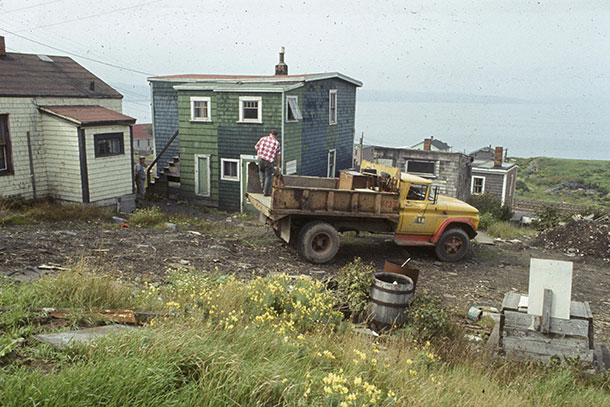Now hailed as a vibrant artists colony, Salt Spring Island, BC counts as its first permanent residents a group of free Blacks from California who settled the landscape in the late 1850s. Street signs bearing names such as Starks Road and Whims Road honour the island’s early Black families. For about a decade, I was among the coterie of contemporary Blacks who call Salt Spring home.
One day during a visit to the Salt Spring library, I was drawn to a book titled The Spirit of Africville. I’d previously read about the “velvet touch” Canadian racism that had facilitated the razing of Africville and other close-knit African-Canadian communities such as Hogan’s Alley in Vancouver (the 1997 film Rosewood showcases the more “rigorous” tactics utilized in the US, where I was born).

But I was stunned to discover that Halifax officials, in the purported guise of being “helpful,” had dispatched municipal dump trucks to relocate many residents of Africville to new homes. Founded in the 1840s by William Brown and William Arnold, two Black men who’d purchased land abutting the Bedford Basin, Africville housed about 80 families when it was demolished, beginning in the late 1960s.
Published in 2010 (by the Africville Genealogical Society and Formac Publishing), here’s a passage from The Spirit … : “Just think what the neighbours thought when they looked out and saw a garbage truck drive up and unload the furniture.”
In Displacing Blackness: Planning, Power, and Race in Twentieth-Century Halifax, author Ted Rutland chronicles the machinations that have led to the degradation of the longest-standing community of Blacks in Canada; a group that, in the absence of government sanctioned oppression, might have emerged as the archetype of Black achievement in North America. But no …
“More than any other Canadian city, Halifax is widely known for a particular example of anti-Black urban planning,” Rutland writes. “Africville is important because of … what happened to the people there, but also because of the broader structure of power that it symbolizes; the centuries-long neglect, plunder and subjugation of Black people in Halifax and across Nova Scotia by the state (in general) and planning (in particular).”
Readers familiar with the Pentagon Papers and its revelations about the deliberate US escalation of the Vietnam War will find resonance in Rutland’s bombshell narrative about Halifax. A faculty member in the Department of Geography, Planning, and Environment at Concordia University, the self-described “white man from Northern Ontario,” outlines his objectives in the text that spans from about 1890 to 2010. Rutland is scheduled to speak at the Halifax Central Library at 7:00 p.m. on Monday, November 5.
“The story of Africville helped to expose my own ignorance about Canadian racism and the role of racism in shaping (advantageously) the circumstances of my own life,” writes Rutland who completed graduate studies at Dalhousie. He notes that his sojourn in the city awakened him to “forms of political and spatial segregation” that stand as the hallmark of the Halifax Regional Municipality (HRM), adding that all whites profit from the pervasive anti-Black (and Indigenous) sentiments in “Canada’s Ocean Playground.”
The author continues: “For a white person … the injustices … are inscribed not just in unjustly higher levels of white wealth or unjustly better white housing conditions but in the very make-up of our bodies and experiences of the world. It is important … to acknowledge … the intimate privileges provided to white people in contexts produced and organized by anti-Black urban planning.”
Those inclined to dismiss Rutland’s volume as “Kumbaya pandering” should check the data upon which he builds his account of the disempowerment of Blacks whose presence in Nova Scotia dates to the early 1600s. In addition to his analysis of myriad works on Africville, the author mines documents from the archives of the Halifax planning department, minutes and reports of Halifax City Council, the records of the Nova Scotia land registry, and the records of numerous civic groups such as the Halifax Council of Women (HCW), to name a few.
Having expressed his need for a “definition of systemic racism,” soon-to-say sayonara Halifax chief of police Jean-Michel Blais (aka “Street Checks R Us”) might consider Rutland’s 68 pages of source notes. Ditto for the next person hired to fill the position for which Blais, in fiscal year 2016, pocketed $205,000, according to municipal records.
There, they’ll find a wealth of information, including a citation related to a 1916 HCW meeting at which members discussed city-owned and operated free-lunch counters where segregation was strictly enforced.
“One member suggested that the policy should be opposed,” Rutland writes, referencing minutes from the HCW meeting. “But another argued that segregation was not the same as ‘discrimination,’ and the matter was dropped.”
Fast forward and readers will find Rutland’s citation from a HRM Planning Strategy document (circa 2005) that detailed a proposed housing development (think: white) near the historically Black communities of North Preston, Lake Loon, Cherry Brook and East Preston.
“In addition to plotting the location of new homes, the planning process sought to determine the ideal distribution of future investments in municipal services and infrastructure,” Rutland writes. Citing HRM planning department records, Rutland notes that residents of East Preston expressed their interest in better water services, bus transportation, the installation of sidewalks, functioning street lights, and the construction of new community and recreation facilities.
“These requests were universally spurned by city planners,” Rutland notes.

Hired in 2014, former Halifax chief city planner Bob Bjerke was fired (without warning), in August 2017. Reading passages from Displacing Blackness one can’t help but wonder if Bjerke envisioned a planning process that valued the voices of African Nova Scotians likely wary of development projects (hatched before his arrival) that are steadily pushing them out of the city’s North End and outlying rural areas to which they’ve been relegated (apartheid-style) for generations.
“I had no plans to leave,” Bjerke noted in a media report after he was sacked. “I am not disappointed,” said Halifax city councillor Matt Whitman about Bjerke’s sudden dismissal. The councillor’s offensive remarks about people of colour and tacit support of pro-white groups has been well-publicized.
In addition to the racist bent of many politicians, Rutland faults the city’s clergy, health officials, legal experts, educators, and media for proffering damning stereotypes about Blacks. He cites an 1850s era editorial in the Halifax Morning Post that decried African Nova Scotians as an “unproductive and destitute” group best suited for slavery. The Provincial Magazine chimed in: “We have no hesitation in pronouncing [ African Nova Scotians] far inferior in morality, intelligence, and cleanliness, to the very lowest among the white population.”
The relentless disparagement of Blacks played out in the process that culminated in the annihilation of Africville. As evidenced by the author’s documentation, the community had, since its inception, routinely pressed Halifax officials (all-white) for better living conditions. Instead, “The most undesirable and noxious facilities in the city had a tendency to be sited on Africville’s doorstep,” Rutland notes. They included: a dump, a tar factory, a slaughterhouse, a fecal waste pit, a prison, and an infectious diseases hospital. The predictable outcome? Fetid air, contaminated water, and battalions of rats.
After more than a century of deliberate abuse and neglect, Halifax city planners condemned, as a “slum,” the enclave they’d helped to create. In doing so, they eviscerated a self-sustaining (albeit beleaguered) Black community that remains under siege. Promises of job training, legal aid, educational programs, and financial support for displaced residents of the blueberry-laden landscape never came to full fruition.
And yet, about Africville, the white owner of a prominent “eco-friendly” Halifax enterprise recently declared, in a private conversation: “I don’t know why the Blacks here just can’t get over it.” Whites inclined to lament the so-called “carping” of African Nova Scotians are well-advised to check their attitude — especially those who’ve now set up shop in previously shunned, as “dangerous,” areas of the city. With a nod to the late Aretha Franklin, I’ll put it this way: Who’s zoomin’ who?
Rutland’s chapter on the Black United Front (BUF) offers an overview of the Halifax advocacy group that formed in the aftermath of the destruction of Africville. Among others, the author salutes future attorney Burnley “Rocky” Jones (1941-2013) for promoting a platform of Black self-determination that, ironically, was later undermined by the organization’s dependence on government funding. Rutland also ventures that the BUF was infiltrated by an informant (with probable ties to the FBI and the RCMP) who fuelled fears about “Black activism and violence.” By 1996, BUF had effectively disbanded.
Last I checked, the Canadian Football League was chockablock with players of African descent. On Tuesday, in a unanimous vote, HRM city councillors approved “further study” of a proposed plan for a CFL stadium in Shannon Park. As for Mayor Mike Savage, he cheerily told the CBC that he has “no doubt that football will be successful if it comes to Halifax.” Well …
Nova Scotia government officials, Maritime Football Ltd. (talking to you Anthony LeBlanc), and other private investors now acting all “brand new” (see the urban dictionary) in their determination to bring a CFL team to Halifax better note that word is out on the province’s horrific racial history. Can you say on-the-job punctured lung by a high-velocity nail gun attack? Or how about a Halifax Transit style “suck me, boy” salutation? And did I mention the racist depiction of a Black woman recently showcased at an NSCC campus for nearly a week? On the door of an Early Childhood Education classroom, no less. Oh, and this just in, last night’s “it’s okay to be white” posters stapled all over the downtown.
This sistah is here to tell you that prospective Black Halifax CFL players ain’t gonna roll with the possibility of their female family members and friends suffering such disrespect. Cue: “Mama said Knock You Out.”
$170-$190 million to lure a CFL team to Halissippi? Ya’ll might wanna draw up another game plan. And all praises to author Ted Rutland for walking worthy.
A slightly different version of this piece first appeared in the Spring 2018 edition of Atlantic Books Today. Republished with permission of the author.
As mentioned in the article author Ted Rutland will be joined by special guests at an event at the Central Library in Halifax, on Monday November 5, 7:00 pm. The event is organized by The Radical Imagination Project.
With a special thanks to our generous donors who make publication of the Nova Scotia Advocate possible.
Subscribe to the Nova Scotia Advocate weekly digest and never miss an article again.



